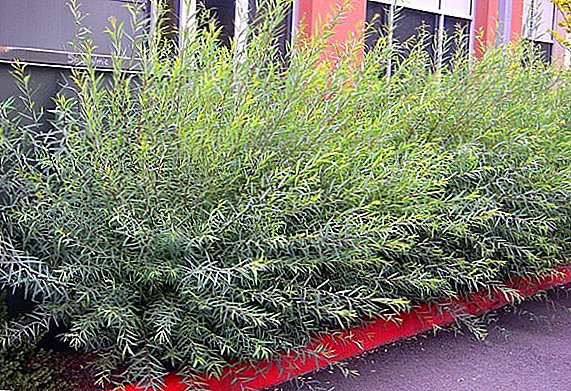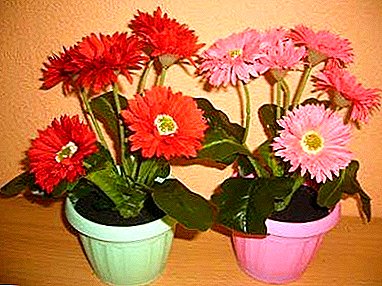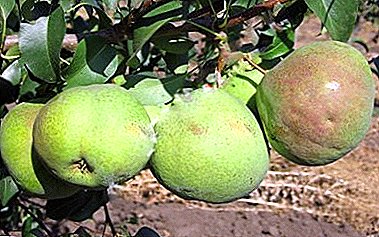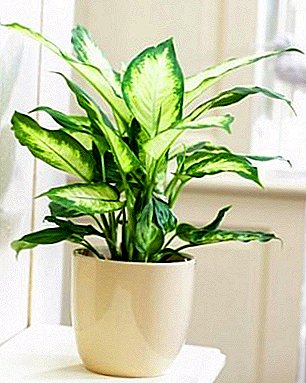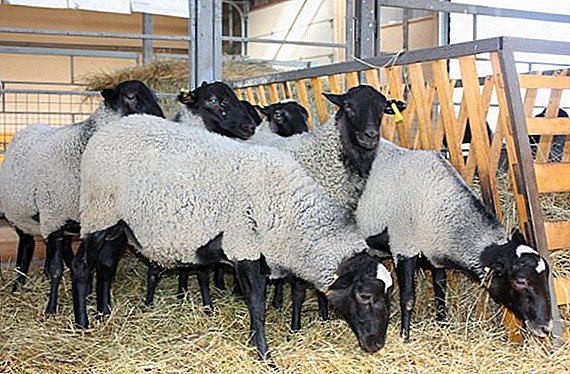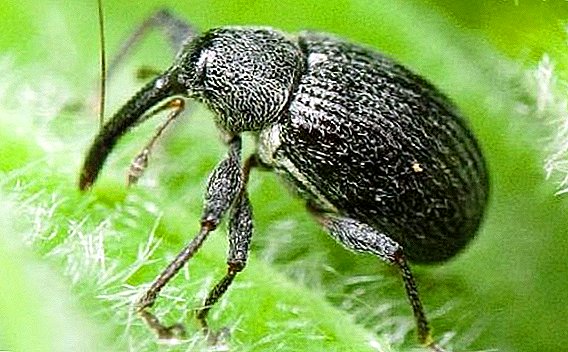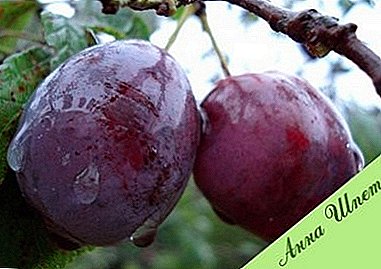
The history of plum as a cultural species has more than one millennium. It came to Russia in the 17th century, and the most widespread in the middle of the 18th century.
Plum is often found in the middle zone of the Russian Federation, but it has gained most popularity in Moldova, the Crimea and Ukraine.
Plum quite a heat-loving tree and is grown mainly in the southern regions.
The most famous, served for many new varieties, resistant to diseases and frost, is a plum variety Anna Speth.
Anna Shpet Plum: variety description
Anna Shpet's tree is very tall, with a wide and dense pyramidal crown and grayish bark. The shoots are thick, dark brown with small internodes. The main branches and shoots are highly durable.
The buds are small, with sharp tips. The leaves are small, oval, with a sharp top, light green, dull, serrated on the edges, without stipules and with a short petiole.
The flowers are large, white, grow two together, on a medium-sized pedicle. Petals are oval, with wavy edges. A few stamens, anthers yellowish.
Berries are large, weighing about 45-50 grams, dark purple with a burgundy shade, oval, without pubescence. They have many gray subcutaneous points, the lateral suture is almost imperceptible. The peel of medium thickness, easily removable, covered with a waxy coating.
The flesh is very sweet, with extremely pleasant dessert taste, yellowish-green, dense, when fully matured - bright yellow, juicy. The stone is small, ovoid, easily separated from the pulp.
A photo
Photo plums "Anna Shpet":




Breeding history
This variety was obtained quite a long time ago, in the late 1870s, in Germany, by the famous German breeder Ludwig Shpet. His main work was the breeding of new varieties of lilac, and the plum variety was grown by chance from the free pollination of an unknown seedling.
This variety was widely spread in the USSR in the 1930-1940s. It was zoned in 1947 in the Rostov, Astrakhan regions of Russia, Krasnodar and Stavropol Territories.
Later it began to grow in the south of Belarus, throughout Ukraine, in Moldova and the Crimea.
Specifications
Anna Shpet is late plum variety, the berries begin to ripen only in late September or early October. Fruits are not showered and can remain on the tree for a long time even after full maturation.
The main advantages of this variety are:
- high yield;
- very large and tasty fruits;
- early onset of fruiting;
- late ripening;
- unpretentious care;
- the possibility of long-term storage of berries;
- high degree of regeneration of the tree.
This is a high-yielding variety, with an adult 20-year-old tree can be harvested around 100-150 kg of berries. Anna Shpet begins to bear fruit already in 4-5 years after landing.
 After being removed from the tree, the berries can be stored for a very long time in a cool place without losing the taste and product quality. Well used for processing and for fresh consumption.
After being removed from the tree, the berries can be stored for a very long time in a cool place without losing the taste and product quality. Well used for processing and for fresh consumption.
By frost, the variety is unstable, however, even with severe freezing, able to recover quickly. But for growing in a cold climate, it is still not suitable, since it becomes low-yielding and is more often sick. It is undemanding to soil and care and can tolerate drought well.
Anna Shpet - the variety is only partially self-fertile, and in order to obtain a better crop it needs additional pollination.
Excellent pollinators for it will be the varieties of plums:
- Victoria;
- Renklod Altana;
- Catherine;
- Early;
- Washington;
- Hungarian home;
- Kirke;
- Renklod green.
Anna Shpet bears fruit annually and very abundantly. But even the most unpretentious plant to get such yields, you need to provide the right care.
Planting and care
It is best to plant a plum in the spring when the earth is completely thawed. Before planting acidic soil necessarily lime. It is important to take into account the location of groundwater. For plums, their level should be no higher than 1.5 m.
For landing better to choose warm, well-protected, sunny placesFor example, near the wall of the house, near the fence or on the south side of the slope. Plum tolerates soil moisture and loves not heavy, loamy soil.
 Planting pits are dug to a depth of about 50-60 cm and with a diameter of 70-80 cm. After installing the planting peg, 2/3 of the hole is filled with a mixture of organic and mineral fertilizers (10-15 kg of humus and a pound of superphosphate) from the top layer of the earth.
Planting pits are dug to a depth of about 50-60 cm and with a diameter of 70-80 cm. After installing the planting peg, 2/3 of the hole is filled with a mixture of organic and mineral fertilizers (10-15 kg of humus and a pound of superphosphate) from the top layer of the earth.
When planting it is necessary to ensure that the root neck of the seedling does not penetrate into the soil, and is 4-5 cm above the soil. The tree is carefully placed in a hole and instilled tightly, leaving a well for irrigation around the roots.
Barrel loosely tied to a peg with a soft rope or film. Nearby must grow at least 2-3 pollinator varieties.
In the first year after planting, the seedling is not fertilized, only watered, loosened and weed the soil. At the beginning of flowering about 80% of the flowers, it is desirable to cut off to facilitate the survival process.
The following year, in June, you can hold the first nitrogen fertilizer. Before the onset of stable fruiting, the tree should be fertilized three times per season: in early May, in June and in late August.
When fruiting becomes regular, the first dressing is carried out before the start of flowering, the second - immediately during the ripening of berries and the third - after harvesting.
Varieties of plums, pleasing their high yields: Firefly, Hungarian Korneevskaya, Memory of Timiryazev, Renklod Altana, Renklod collective farm, Renklod Soviet, Kroman, Blue gift, Starting, Morning, Bolkhovchanka, Skoroplodnaya.
To do this, you can use a solution of urea, potassium superphosphate or nitrophoska. Fertilizers are applied only in moist soil, after which it is carefully loosened. In the fall nitrogen supplements eliminate.
Every year, during the season, after weeding the soil must be loosened, watered and well mulched with humus. Sort Anna Spet prone to root growthwhich must be removed.
Also an important procedure in the care of the plum is regular abundant watering and proper pruning.
The first pruning is carried out at the time of planting: all branches are cut to 1/3 of the length. Further, pruning is carried out annually, in early spring.
 First of all, frost-damaged and diseased branches are completely removed. When thinning young shoots, leave only the strongest and most direct. You can not cut a large number of shoots and branches at a time. You can remove no more than a quarter of the total mass.
First of all, frost-damaged and diseased branches are completely removed. When thinning young shoots, leave only the strongest and most direct. You can not cut a large number of shoots and branches at a time. You can remove no more than a quarter of the total mass.
When the tree stretches to 2-2.5 m, then begin to form the crown. The top and all vertical branches are pruned, with strong thickening - thinned.
Diseases and pests
Of the significant drawbacks can be identified:
- average winter hardiness;
- propensity for moniliosis and polystygnosis.
The plum variety Anna Shpet is not very resistant to diseases such as polysigmosis and moniliosis.
Polystigosis or red spot - This is a fungal disease that affects the leaves of plum and cherry plum. It manifests itself in early summer, after heavy spring rains, in the form of small yellowish spots on the leaves.
These spots grow very quickly and take on an orange first and then a bright red color. If the plant is not treated in time, the disease can lead to full fall of the leaves, which leads to the weakening of the tree and reduces its frost resistance.
Prior to fruiting, the diseased tree can be treated with Bordeaux mixture or special fungicides. After harvesting, autumn, good helps spraying the leaves and the soil under the tree blue vitriol. And be sure all the fallen leaves should be raked and burned.
Moniliosis, in contrast to the red spot, affects not only the leaves, but all parts of the plant. Affected leaves and shoots become brown and dry out. The berries are covered with small gray growths and begin to rot.
Measures to combat this disease are in many ways similar to the treatment of polysigmosis, and consist in timely cleaning of leaves pruning diseased branches and shoots; and processing wood with Bordeaux mixture and fungicides.
 Variety Anna Shpet very often suffers from frost damage and rodent attacks.
Variety Anna Shpet very often suffers from frost damage and rodent attacks.
Therefore, for the winter the young plant should be wrapped completely, and in an adult - carefully cover the trunk with the help of thick thick fabric wrapped with a polymer mesh.
This will help protect the tree not only from frost, but also from damage by hares and mice.
Despite the emergence of a huge number of new varieties of plums that are resistant to disease and frost, Anna Shpet is well suited for planting at the dacha.
Indeed, in comparison with the advantages, there are not so many disadvantages.




